Whats wrong with baby chicks that are sick, unwell or dying?

So you have bought or hatched a batch of gorgeous fluffy little chicks and now one or two have died and a few others are looking a bit sick and unwell.
If you do not know what is wrong with your chicks or you are unsure on how to treat them then you need to consult a veterinarian.
Table of Contents
- Do baby chicks get sick easily?
- What do healthy baby chicks look like?
- Symptoms of sickness in baby chicks:
- Causes of illness and death in chicks:
- Mareks Disease:
- Respiratory problems:
- Brooder Pneumonia:
- Eye problems in chicks:
- Pasty butt or Pasted vent:
- Genetic conditions in baby chicks:
- Polyneuritis, Torticollis and stargazing in chicks:
- Scissor or crossed beak in chicks:
- Splayed or Spraddle leg:
- Can you get sick from your chicks?
- How to care for sick baby chicks:
- Feeding sick chicks:
- What is starve out in chicks?
- Treating chicks after shipping:
- How to keep your baby chicks healthy:
Like all conditions and afflictions that affect chicks at the various stages of their lives they are all better prevented than treated.
When treating sick chicks it is advisable to skip the home remedies as conditions often progress very fast in young chicks.
Do baby chicks get sick easily?
Baby chicks can get sick easily and do die quickly so any remedial action will need to be taken straight away.
Affected baby chickens will appear dull, drowsy and lifeless and may sleep more than usual . Conditions affecting the lungs will cause panting and gasping. They may flop down and show weakness on one side or in the legs.
Below: This is a sick chick. Notice the puffy eyes and face and the fluffed up look.
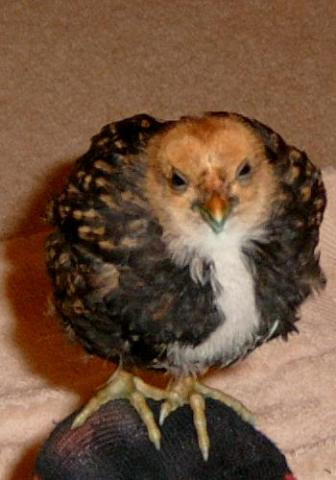
What do healthy baby chicks look like?
A healthy chick will have clean and dry bum, bright eyes, be active, move freely and peep to itself as well as being happy around it's brood mates.

This is very important : - Do not confuse a warm chick that will pant to cool itself and one that is gasping for breath. The former will pant a little like a dog with an upright stance and the second will have laboured breathing with the head outstretched in front to open the airways.
With a panting chick you will see a rapid flutter of the chest as it breathes fast and shallow and a chick with problems breathing will struggle to take deeper breaths.
Symptoms of sickness in baby chicks:
I hatch several thousand chicks a year using booth broody hens and artificial incubation and I have learned a few things over the years.
Below: The result of a test hatch of New Hampshire Red Bantams.
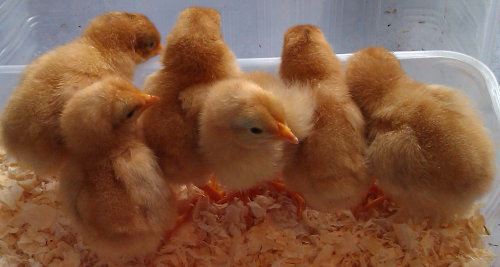
These are the things to look out for when assessing the health of your chicks.
- Lethargy - Sleeping a lot and just standing around. Chicks should be active.
- Bloody or red poop – Signs of Coccidiosis or internal problems.
- Blocked or pasted vent – See pasted vent below.
- Diarrhoea - Runny poop can be a symptom of infection.
- Huddled - Chicks piled up or huddling are cold.
- Pale – Just the face in chicks as they do not have comb and wattles.
- Gasping or Gaping when breathing – With the neck outstretched.
- Puffy, swollen or discharge from the eyes - Mycoplasma infections often show up as bubbles in the eyes.
- Head back over the shoulders - Torticollis or star gazing.
- Gait – Problems walking . The chick may be limping or fall to one side.
- Drooping wings – Chicks stabilising itself by dropping it’s wings to the floor.
- Bad smell – From the beak, the brooder or the navel of the chick.
- Rattling breathing – Rasping sound of wet breaths.
- Lesions or sores – Sometimes on the wattles and face but also the head and body.
- Hunched and ruffled appearance - Chickens in pain stand still and ruffle up.
- Standing away from the others on it’s own.
- Not eating well or properly - Could indicate a blockage or genetic defect.
- Not drinking.
- Loud cheeping - Noise chicks are in distress.
- Swollen Navel or mushy and / or discoloured abdomen - Mushy chick disease.
- Unthrifty or not growing properly and not keeping up with it’s brood mates.
Chicks should be active in bursts and then sleep for a while to recharge. They should feed and drink regularly and peep quietly to each other.
Below: Chicks like this Serama have naturally low and droopy wings.

Not all of the above sign mean a chick is unwell. They may just be unhappy over something.
Causes of illness and death in chicks:
- Cold or low brooder temperatures.
- Heat , high temps or no cool spaces in the brooder.
- Draughts, they effect all poultry.
- Damp brooding areas allow diseases to thrive.
- Fungus growth.
- Pathogens.
- Eating and feed problems.
- Genetic factors.
- Drowning.
- Crushing and or poor handling techniques.
- Coccidiosis
Chicken keepers should be aware of the importance of the rearing stage in the birds life. After the excitement of the hatch there is a tendency for the keeper to slacken off a little and not be as diligent as they should be.
Newly hatched chicks are vulnerable to quite a lot of things that can kill them. Their chances are poor if you're brooder and husbandry technique is not up to scratch.
Below: Chicks may be dopey and stand still occasionally.
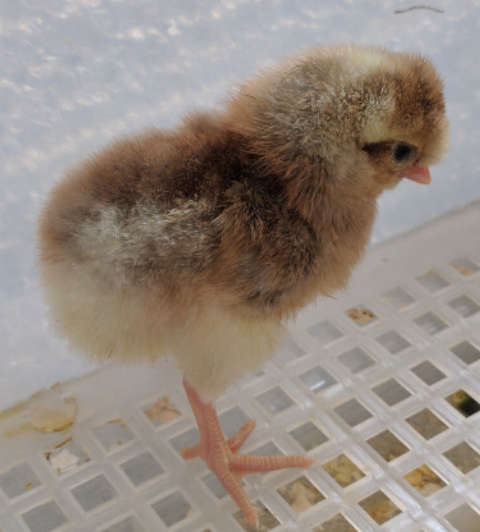
Chicks sometimes look lost inside their own mind. It is natural when they are very young.
The cold. Chicks are at their most vulnerable in the first few week of life until they grow their feathers and grow up a bit.
The cold will cause chicks to huddle together and they may bleat loudly and continuously. If the temperature is low enough it will kill the chicks in a few hours otherwise it will make them unthrifty and slow. Huddling chicks may smother their kin by standing on them and squashing them.
The heat. This one always seem to surprise people but too much heat is just as bad as cold. I see as many brooders that are too warm as I do cold.
Chicks will pant and squish themselves into the corners in an attempt to escape the heat. They will also drink much more water leaching precious minerals and salts from the body.
Below: Loud cheeping shows distress in baby chicks.
A brooder pen with a rounded edges like a cardboard ring will help prevent piling in corners and smothering.
The secret is two separate and adjustable heat sources.
Make sure they are not in a place where the sun may fall on the brooder and they can not escape.
Draughts are bad for chickens of all ages but before they grow their feathers they are problematic to the extreme. Whisking away body heat and not allowing them to sleep properly.
Consider your brooder position. Away from sunshine and draughts is best.
Damp allows the rapid growth of fungus and pathogens in the bedding, water and feed. and if the water evaporates of a wet chick it causes cooling. It is vital you provide a clean safe environment in which to develop.
Moist bedding in the brooder can be caused by the chicks drinking too much water from salty feed or insufficient surface area in the brooder, from having too many chicks in too small a space.
Below: Chicks not feathering properly can be a sign something is wrong.
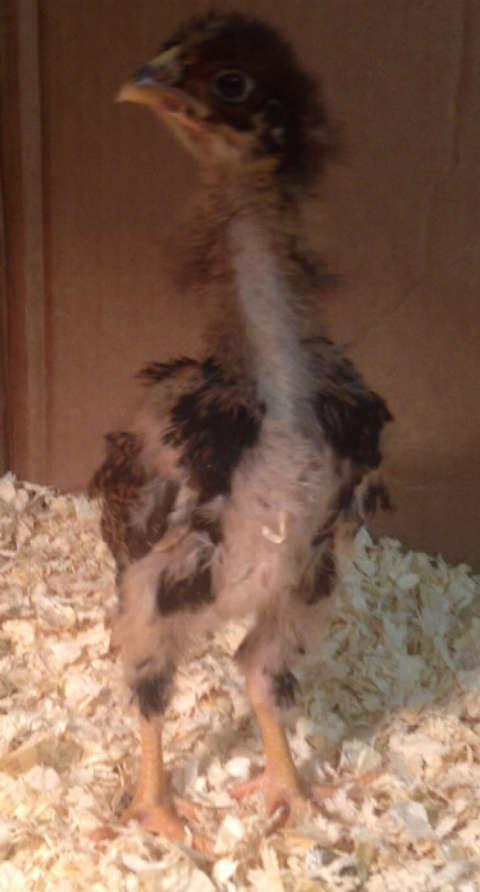
A chick not feathering properly may mean the brooder is too hot for too long or too crowded. Again some breeds feather slowly.
Fungal infection like brooder pneumonia or aspergillosis will kill a chick in as little as 24 hours and mortality rates are 100%. You should not subject the respiratory system of a baby chicken to strong perfume or wood oils like cedar-wood.
Pathogens or bacterial infection. Mushy chick disease or yolk sac infection is caught from poor incubator hygiene or dirty egg shells and is transferred to the chicks during hatching.
This is easily prevented with by good hygiene and practices but you will more than likely have to resort to an antibiotic for infections.
Pasty bottoms may or may not be caused by disease as it has several causes and is actually quite common in artificially reared chicks in the first few days.
The actual bug that causes the disease is relatively unimportant. If you live in a country that requires a vet to prescribe drugs then you will need a quick visit or get hold of antibiotic like TYLAN.
Chicks have a greater need for water than they do for food in the early days. They can be easily knocked into their water by their brood mates so it is important that your water supply does not pose a risk to drowning.
Food and water need to be clean, in date and of sufficient quality. Dirty water may harbour disease and fungal spores in old or damp feed may produce toxins that will kill quickly. eating the bedding or shaving can lead to impaction in the digestive system and bung them solid inside.
Cover the bedding for the first few days until they learn to feed on the crumb properly. Failure to do this means they can start to eat the bedding and wood shavings are indigestible, another good reason to use sand as the brooder floor.
I keep my water at one end of the brooder and the feed at the other. This promotes activity and muscle growth and helps prevent crowding around a feeder or drinker.
Chicks are born with a supply of food inside them. The yolk is adsorbed into the body just before hatching and nourished the chick for around 72 hours after hatching. Some seem to struggle to learn to feed properly and the odd one may may never start.
Baby chickens are naturally curious and will investigate their surroundings .You can imitate the mother hen by picking up a little crumb and sprinkling it on the paper to attract the chicks attention. Or make a pecking motion with you fingers to get the little ones interested.
Below: You should not breed from chicks that are substandard.
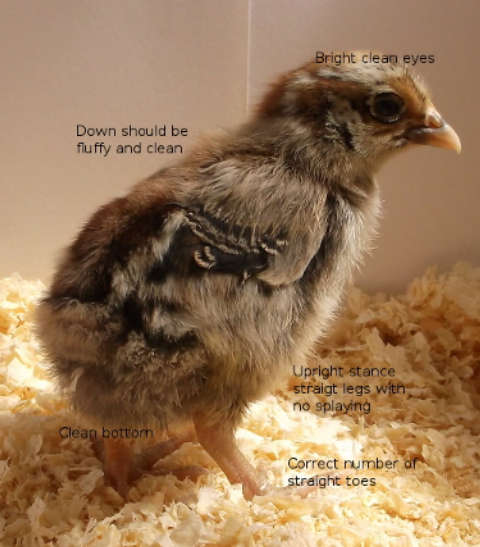
Genetic disorders. Knowing which breeds have known issues, lethal genes and genetic problems. this is an issue inherited from the parents and may not be apparent until hatching. Good breeding practises and parental choice will prevent this.
Splayed legs is an example and is generally a result of baby birds hatching with under developed hip joints.
Drowning. Chicks are prone to drowning, especially when newly hatched. It takes them a day or so to find their feet and gain some strength. before that they can drown easily.
Add pea gravel or marbles to the water to keep it shallow. To avoid wetting and drowning of young chickens use shallow water trays or fill with marbles or something similar so the chicks can get to the water without being able to get wet in it.
The solution is to use very shallow water or chick waterers with small holes. This is what I use and recommend you do as well. I never use plastic.
Below: The recommended galvanised metal feeder and drinker.

Suitable for feed and water they come in 2 sizes for 12 or 30 birds. The chicks cannot drown in them and they can not crowd each other away from feed.
Crushing. Falling feed troughs or waterers can trap and kill chicks in no time at all. Electric hens that turn over when bigger chicks try to get on top of them and lamps or holders that fall can crush chicks or start fires..
Some chicken keepers, me included , believe that chicks hatched in an incubator are at a disadvantage as they do not benefit from the example set by the mother hen. This chick got tangled in a small bit of frayed string. Chicks can panic and die in no time at all.
Below: Young birds piling in the corner.
I prefer to use a hen but it is not always possible. If they don't teach the chicks then you have too.
I once saw a Facebook post suggesting you should pick your chicks up by the head and let them dangle to see if they are male or female. NO, please don't, this is not a valid method of sexing and may cause injury and death.
Coccidiosis. I have given this it's own section here as it is responsible for a lot of problems with young birds. It is ameboid parasite that can effect all chickens from mild discomfort to killing them.
Feeding a medicated crumb will keep it at bay long enough for it to develop resistance. All birds should be treated regularly with corrid or similar.
Coccidiosis is the number one cause of death in baby chicks, Coccidiosis is a highly contagious parasitic disease of the intestinal tract.
It damages the intestinal wall during it’s life cycle. There are 6 types which infect chickens.
Red-tinted or bloody stools and lethargy are some of the sick chick symptoms that indicate Coccidiosis. They have a hunched look with ruffled feathers or fluffed down.
Fresh medicated feed will give the chicks the chance they need. This condition is one all chickens have and in normal conditions their immune system keeps it under control
To treat Coccidiosis you will need to resort to a chemical intervention like Corrid. Home remedies are a supportive treatment to make the bird feel better, they are very unlikely to work in time to save young chicks. The only other thing you can do is make sure that the birds are not exposed to fresh oocysts by keeping the bedding clean and fresh.
Immunity is not transferred from the hens to their chicks and the chicks will get exposed to Coccidiosis in the first few weeks of life and will go on to develop immunity with or without clinical disease.
Fresh as opposed to old or stale chick crumb which has been medicated with a coccidiostat is their best chance.
Treatment for Coccidiosis should be as needed rather than a regular thing. You need to allow immunity to build within the bird over time and over treatment stops this process.
Mareks Disease:
Mareks is the collective name for several highly contagious viral diseases that cause tumours and lesions which can lead to paralysis in sick chicks and spread bird to bird or via infected dust and dander.
It is a herpes virus that carries no risk to humans at all. Immunity is achieved by healthy chicks surviving exposure or vaccination.
Read more about Mareks in detail.
The Mareks vaccination offered by many hatcheries and breeders is not 100% effective but it is enough to provide herd immunity. This also means the bird may still contract the disease but it will not display symptoms and will recover much more quickly. A clean brooder with no chance of cross contamination from outside birds is your best prevention in chicks.
To treat chicks you suspect have contracted Mareks you must separate them from the others. There is no treatment for Mareks disease and the vaccine is ineffective one the bird is infected. Make sure affected chicks continue to eat and drink, and are keeping their immune systems strong, those chicks have a better chance at surviving.
Respiratory problems:
Chicks have relatively simple lungs but complex respiration systems and are susceptible to breathing problems.
Sick chick symptoms related to respiratory issues are runny or bubbling eyes, coughing, sneezing and crusty or runny nostrils. Sometimes also the symptom of a more serious illness, often these sick chick symptoms are merely caused by irritants in the brooder.
To prevent irritation use Sand or large-sized pine chips as brooder bedding to cut down on dust. Never use cedar shavings since the oils and aromatic scent can irritate chicks lungs and sinuses. Use white vinegar and water to clean the brooder instead of bleach, which when mixed with the ammonia in chick poop can create toxic fumes.
Brooder Pneumonia:
Brooder Pneumonia or Aspergillosis is an infection caused by a type of mould or fungus that grows in the damp litter in the brooder. The spores that cause the infection are everywhere in the environment and the only way to prevent it is keep the brooder completely dry.
It affects the lungs primarily causing shortness of breath. Since I switched to using sand in the brooder I have never had this problem.
Eye problems in chicks:
Most chicks suffer the odd eye irritation at some time.
It is normally caused by dust from the bedding or a peck from a brood mate. Likely hood is it will clear up in a day or two on it’s own. Boiled water cooled to 35C/95F and used to bathe the eye may help if needed.
Bubbles in the eyes or swollen eyes are indicative of an infection like Mycoplasm which will need antibiotic treatment within 24 hours.
Pasty butt or Pasted vent:
This occurs when faeces stops up a chick’s vent so they can’t excrete. It is not necessarily caused by disease but may be. It is quite common in the first week or so for chicks that been artificially incubated.
This condition is most common in shipped mail order chicks, much less common in ones you hatch yourself and quite rare in chicks raised naturally by broody hens.
It may also be caused by stress or temperature fluctuations, keep your brooder temperature constant and don’t let children or household pets harass your chicks. Change out wet and soiled brooder bedding regularly.
Dirty vents should be cleaned off carefully with a q-tip dipped in olive oil and checked and lubricated as needed. It can take a few days. Trim the down carefully around the vent as well to help prevent it.
Chick grit and some fresh greens like finely chopped spinach help.
Genetic conditions in baby chicks:
You should never breed from a bird with a genetic malformation. This chick below seems to have a malformed skull leading to eye and beak problems.
Below: Genetic conditions often present with skull or bone deformations and the chicks rarely survive.
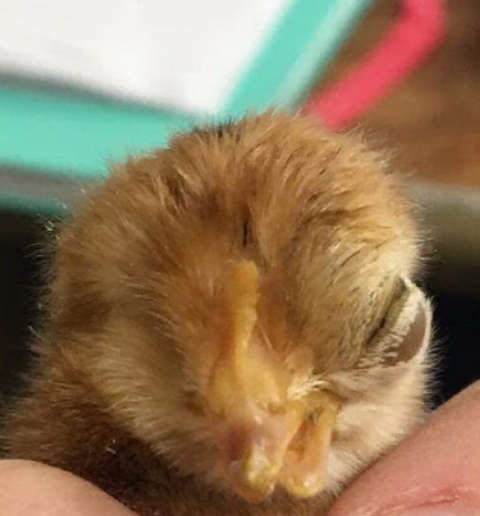
Below: Yolk sac malabsorbtion can be genetic or caused by incubators that are too hot.

Polyneuritis, Torticollis and stargazing in chicks:
This is a condition where a chick is unable to hold its head up properly, it may droop to the floor and be pulled over the chicks back or even to one side or the other. The chick will be unable to feed and walk normally and instead walk backward.
It can be caused by caused by a Vitamin B (thiamine) deficiency, certain disease that cause nerve lesions or be a genetic issue. Brewer’s Yeast in the chick’s daily feed.
Brewer’s yeast is an excellent source for thiamine, or you can administer something like Nutri-Drench to the affected chick. Genetic problems or lesions on nerves are unlikely to end well and the chicks should be euthanize.
Scissor or crossed beak in chicks:
This is a deformity in which the top and bottom of a chick’s beak does not line up properly. It is genetic and will likely worsen over time as the chick grows and the bird will be unthrifty and may not be able to feed itself properly or at all.
To prevent in the future do not breed any chicks with the condition. Or the cockerel or hen whose egg hatched the chick with scissor beak.
There is no treatment and the birds are best humanely destroyed if the condition is bad enough that they can not eat.
Splayed or Spraddle leg:
A condition whereby one or both legs slip out to the sides making a chick unable to stand or walk.
It has both genetic and environmental causes like incubator temperature being too high or fluctuating too much. It can appear in day-old chick hatches if the brooder floor is too slippery for the chick to grip. Sometimes spraddle leg is caused by a vitamin deficiency.
Cover your brooder floor with rubber shelf liner or paper towels, not slippery newspaper. Builders sand is the best for brooder floors.
Wrap a band-aid or some tape around the legs to stabilise them for a few days. I have even seen duct tape used. Monitor the chick to ensure it isn’t being trampled by the other chicks and can access the feed and water.
My own personal opinion on this condition is that the chicks should be humanely destroyed. I have not had a case of this is nearly 10 years with birds I breed myself because of my harsh selection methods.
Below: Minor toe and foot deformations can be corrected with a pad and tape but major deformations should be culled.

The chick hatched with the toes curled up. may affect one or both feet. The treatment is to tape the foot flat on a support like sturdy card or plastic sheet. It should correct itself in a week or two.
Can you get sick from your chicks?
It is very unlikely you would catch anything in the way of diseases from your chicks, especially if you take the precaution of washing your hands after handling them and keep them clean and dry.
Ecoli and salmonella are very rare possibilities from chicks and chickens. Wash your hands.
It is impossible for humans to catch Mareks and Coccidiosis from chickens.
You could in theory catch pneumonia (aspergillosis) but only if you are already immuno-compromised.
I have come across anyone who has been made ill by their chickens.
How to care for sick baby chicks:
Finding a vet that knows chickens is surprisingly quite difficult.
When I first started out the first two vets I visited with chicken problems took one look in the box and told me “Diagnosis is post mortem with chickens” and then “here’s something to put in the water”
Fortunately I now have a farm vet who keeps chickens himself and is very good. You should always try to find a farm vet as opposed to a small animal practice as they are generally better acquainted with livestock and they are a third the price.
Below: This Welsummer chick is unable to stand because of joint malformations. It is also likely in pain and will never recover.

The first thing to do with sick chicks is to quarantine them from the others.
Write down a list of their symptoms and the order and time that you noticed them appearing.
Feed and water the sick chicks after the others so you are not spreading the bug to the well birds.
A couple of drops of molasses in warm water can help perk up a hungry chick. Corn syrup or honey will do as well.
A cooked egg yolk crumbled up is excellent food for chicks.
Feeding sick chicks:
Feeding and watering a sick baby chick need quite a lot of care and attention. It is easy to drown a chick by forcing them to drink or choke whilst trying to get them to eat. This baby chick has a solid crop, probably from eating floor shavings.
Below: The location of the crop in baby chicks.

Assuming the chick has had a few hours to get to grips with it's new home in the brooder the first step is to pick it up gently and dip it's beak in the water. This is normally enough to get things moving and you will see the little tongue moving in the beak.
The next stage is to drop water onto the beak just one drop at a time from a syringe or something similar. Add the drop and let it run into the beak. If the bird does not begin to drink at this stage it may never.
Some can take a day or two and you should not be worried unless 24 hours have passed and it still is not drinking.
The first stage of feeding is to drop some chick crumb onto a surface from your pinched fingers so as the chicks hear and see it. This mimics the mother hens actions.
There is not really a second stage to getting chicks to eat. If a chick is too sick to feed itself then the only option is a liquid diet administered drop wise.
Beyond a certain stage of illness, birds seem to stop eating and drinking and there is not much you can do about it unless the treatment works before they die.
Good foods to feed baby chicks:
- Chick crumb. This should be the bulk (80 to 90 %) of their diet for at least 6 weeks and probably 8.
- Grit without shell. Yes all bird need it and they need to be used to getting it. Chicks don't need the extra calcium from shell.
- Grated boiled egg.
- A little chopped spinach (green)leaves.
Foods to avoid giving to baby chicks:
- Yogurt. Or any dairy. It is not really good for chickens at all.
- Water additives. Unless you need to medicate this way just plain , clean, fresh water. No apple cider vinegar.
- Scraps or treats. it will interfere with the balance of nutrients and their growth may suffer.
What is starve out in chicks?
This is when a chick refuses to eat and or drink.
In my experience it happens to about 1 in 100 chicks.
Below: Chicks that don't eat will not grow properly. You can clearly see the difference in size and feathering.
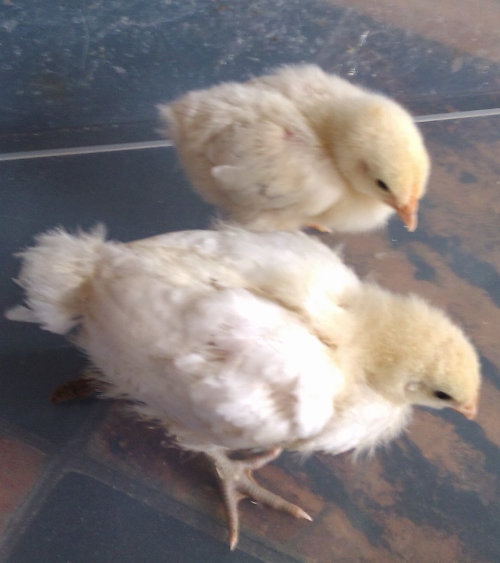
The chick will not grow and will waste away within 100 hours.
It is caused by deficiencies, malformed brains and blocked digestive systems.
The only avoidable cause I know of is chicks eating the bedding before the feed. The drink water and the shavings swell and block the crop or the digestive system.
Treating chicks after shipping:
This is uniquely US problems as the shipping of day old chicks has been illegal in the UK and Europe for many years.
First things first, get them in the warmth of the prepared brooder.
Below: Chicks need care after shipping.

Some warm water with molasses, honey or corn syrup mixed in.
A good feed will get them back on their feet.
Some grated boiled egg, still warm is another fine thing to feed young chicks in need of a good feed.
How to keep your baby chicks healthy:
The heat source of choice for the backyard chicken keeper for chicks is generally a light bulb, heat lamp or ceramic brooder.
The secret to keeping chicks at a happy temperature is to have a hot spot directly under the source and a gradient to cooler areas in the brooder.
This results in a Goldilocks zone for the chicks but also areas where they can warm up or cool down if necessary.
Also use two heat sources as a fail safe. If one light bulb blows overnight you will have dead chicks by morning if you do not.
Below: Good food like medicated chick crumb will help keep chicks healthy.
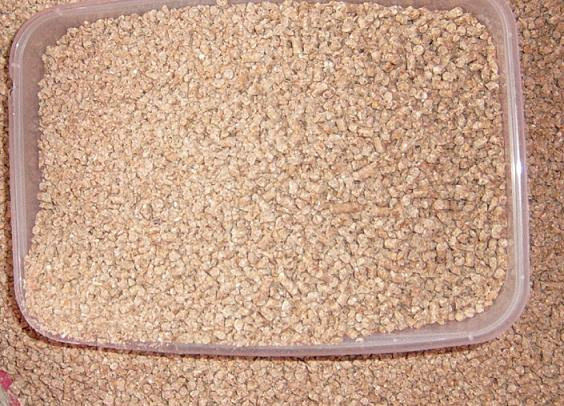
I have taken to using sand as the bedding in the brooder. My builders merchant sells it a sharps sand and it costs about £2.20 for 25KG or about a third the price of shavings. Just spread an inch or so n the bottom of the brooder and leave till it's dry and crumbly and the its ready for the little ones.
It needs to be completely dry which can take some time but it has several real advantages.
It hold heat better than wood shavings or straw (hay) and is no where near as combustible as the traditional bedding for poultry.
You can also see at a glance if it is damp and is does not harbour spores like shavings and bio bedding.
It doesn't matter if the eat a bit of it. Chicks raised naturally with a hen will be taught to eat grit from day 1 and it wont bung them up like indigestible wood shavings. Grit is beneficial at all stages of a chickens life.
Sand from the brooder can go in the compost heap the same as any other bedding.
Time spent just watching your chickens is never wasted regardless of their age. Getting in the habit of looking for issues in the early growing stages is key to success.
Careful observation allows you to spot the symptoms at the earliest time and nip the problem in the bud before it develops or spreads.
Further reading - the complete guide incubation and hatching
